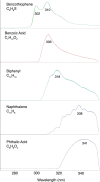Diverse organic-mineral associations in Jezero crater, Mars
- PMID: 37438522
- PMCID: PMC10371864
- DOI: 10.1038/s41586-023-06143-z
Diverse organic-mineral associations in Jezero crater, Mars
Abstract
The presence and distribution of preserved organic matter on the surface of Mars can provide key information about the Martian carbon cycle and the potential of the planet to host life throughout its history. Several types of organic molecules have been previously detected in Martian meteorites1 and at Gale crater, Mars2-4. Evaluating the diversity and detectability of organic matter elsewhere on Mars is important for understanding the extent and diversity of Martian surface processes and the potential availability of carbon sources1,5,6. Here we report the detection of Raman and fluorescence spectra consistent with several species of aromatic organic molecules in the Máaz and Séítah formations within the Crater Floor sequences of Jezero crater, Mars. We report specific fluorescence-mineral associations consistent with many classes of organic molecules occurring in different spatial patterns within these compositionally distinct formations, potentially indicating different fates of carbon across environments. Our findings suggest there may be a diversity of aromatic molecules prevalent on the Martian surface, and these materials persist despite exposure to surface conditions. These potential organic molecules are largely found within minerals linked to aqueous processes, indicating that these processes may have had a key role in organic synthesis, transport or preservation.
© 2023. The Author(s).
Conflict of interest statement
The authors declare no competing interests.
Figures











References
-
- Steele A, McCubbin FM, Fries MD. The provenance, formation, and implications of reduced carbon phases in Martian meteorites. Meteorit. Planet. Sci. 2016;51:2203–2225. doi: 10.1111/maps.12670. - DOI
-
- Millan M, et al. Organic molecules revealed in Mars’s Bagnold dunes by Curiosity’s derivatization experiment. Nature Astronomy. 2022;6:129–140. doi: 10.1038/s41550-021-01507-9. - DOI
LinkOut - more resources
Full Text Sources
Miscellaneous

